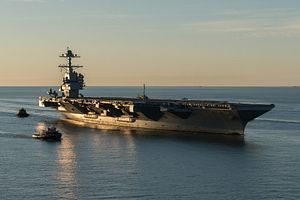The U.S. Navy’s long-delayed nuclear-powered Gerald R. Ford-class aircraft carrier USS Gerald R. Ford (CVN-78), the lead of ship of the United States’ latest class of carriers, has finally been delivered to the service in Newport News, Virginia on May 31.
The delivery followed successful completion of acceptance trials on May 26 conducted by the U.S. Navy’s Board of Inspection and Survey, as well as builder’s sea trials in April overseen by Huntington Ingalls Industries-Newport News Shipbuilding and the Navy’s CVN 78 Program Office, among others.
The USS Gerald R. Ford, once commissioned, will be the U.S. Navy’s most expensive warship to date. Total cost for the lead ship of the class are estimated at almost $13 billion including $2.3 billion in cost overruns due to the ships’ many new and unproven systems, including two main turbine generators, a new dual-band radar system, advanced weapons elevators, and a new advanced arresting gear on the flight deck. The ship was originally slated to be commissioned in the summer of 2016.
U.S. President Donald Trump personally objected to the installation of some of the new systems such as a new General Dynamics’ new electromagnetic aircraft launch system (EMALS) aboard the USS Gerald R. Ford, as I explained last month:
The EMALS technology has recently come under critic by U.S. President Donald Trump who thinks that the U.S. Navy should abandon electromagnetic catapults and return to a steam-powered launch and recovery system.
“I said what system are you going to be–‘Sir, we’re staying with digital.’[EMALS] I said no you’re not. You going to goddamned steam, the digital costs hundreds of millions of dollars more money and it’s no good,” Trump told Time Magazine in an interview on May 11.
According to the U.S. Navy, “the next generation of aircraft carrier, the Gerald R. Ford class delivers unprecedented flexibility to the fleet. Due to a larger flight deck, the ability to host more aircraft, additional weapons and aviation fuel storage, and the Electromagnetic Aircraft Launch System and Advanced Arresting Gear, Ford will be able to increase sortie rates by one-third when compared to the Nimitz class.”
In addition, “the Navy’s newest aircraft carrier generates three times the amount of electricity as previous classes and is designed to rapidly add capabilities as new systems become available over the course of its projected 50-year service life.” The new supercarrier is expected to be commissioned this summer and is slated to achieve initial operational capability in 2020.
The U.S. Navy intends to induct a fleet of up to ten Ford-class aircraft carriers in the coming decades. The 100,000-ton Ford-class constitutes the first new carrier design since the Nimitz-class in 1975. The lead ship of the class is the first new aircraft carrier to join the U.S. Navy’s surface fleet since the delivery of the Nimitz-class carrier USS George H. W. Bush in 2009.
































